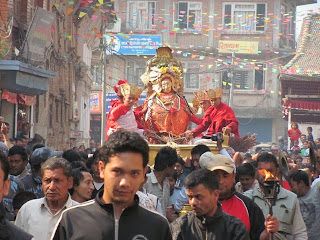Shri Swasthani Brata Katha is a popular ritual observed in Nepal in the Poush month (January – February) during winter. The ritual is dedicated to Goddess Shree Swasthani, a Goddess known to grant wishes of her devotees. The month long telling of the tales are dedicated to the Goddess and the stories that are mainly narrated are those of Swasthani Devi, Lord Shiva other Gods.
Goddess Shree Swasthani is usually portrayed as a four-handed deity with charka, trishul, sword and lotus in each hand sitting at the center while Asta Matrika or eight deities of power – Mahakali, Baishanavi, Brahmi Maheswari, Kaumeshwari, Barahi, Indrayani and Chamunda painted around her.
It is believed that Goddess Swasthani helped Goddess Sati overcome her troubles after she burned herself at Daksha Yagam after hearing her husband, Lord Shiva, being insulted. As per this legend Goddess Swasthani helped Sati overcome the troubles and then to reincarnate and win over Lord Shiva as her husband again.
During Swasthani Katha, Hindu married women observe brata or fasting for the wellbeing of their husbands and unmarried women observe the Vrata in order to get a good husband. Women wear red colored clothes and bangles during the one-month period as it is believed that red is a sign of good luck. The Brata is observed for one month by some women.
The month long rituals associated with Swasthani Katha takes place on the bank of rivers. In Kathmandu the festival takes place at Salinadi, a river associated with the Swasthani brata katha, situated in Sankhu. The holy river is know as Salinadi river where men and women worship Goddess Madhav Narayan.
During the holy period, in the morning or evening the Goddess is worshipped by family members, amid chanting of holy hymns from the book Shree Swasthani Brata Katha which narrates the divine leelas of Swasthani Devi. After the chanting of mantras stories are read by an elderly male or female member.
The stories mainly revolve around the theme – how some devotees due to ignorance take the side of Adharma and are later rescued by the Goddess. Some stories narrate who the goddess rescues her devotees. A major highlight in the stories is the prominence of Swasthani Devi over other gods in the Hindu Pantheon.
In the first few chapters of the 31-chapter book, episodes related to Lord Shiva’s wife Satidevi’s sufferings and her bearing them with courage and, eventually, Shree Swasthani rescuing her from her troubles and agonies, are explained.
During the Vrata period, after early morning shower the pooja of Shree Swasthani begins. In the evening chanting of brata katha or stories is a must. The routine shouldn’t break. It should go on uninterrupted for one month from the date of commencement. At the completion of chanting hymns, flowers and fruits are to be distributed among all those listening to brata katha.
On the concluding day of puja on a copper plate the holy symbol of Om is painted and a Shivling using mud is erected on it. Later, pooja of the Shivling takes place and this concludes the Shree Swasthani Barta Katha.
Most of people of sankhu have Swasthani Book in newar language with hand writtnen. So the story narration is little different in some places than new nepali language book.






























